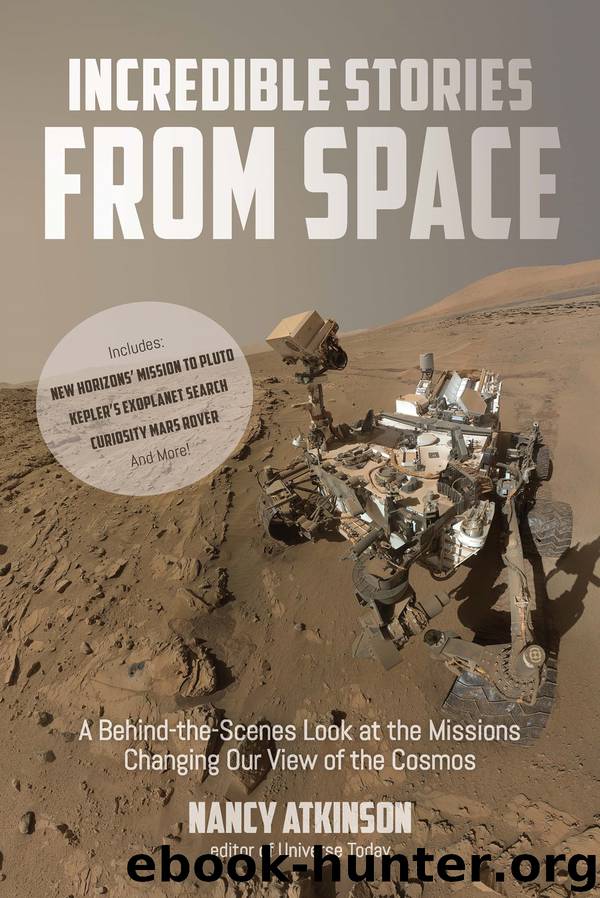Incredible Stories from Space by Nancy Atkinson

Author:Nancy Atkinson
Language: eng
Format: epub
Publisher: Page Street Publishing
Published: 2017-02-13T16:00:00+00:00
THE FUTURE OF PLANET HUNTING
Bill Borucki retired in 2015, passing the torch on to the next generation to continue the search for other worlds.
“My greatest honor has been the opportunity to develop and lead the Kepler mission. It showed the galaxy is full of Earth-size planets orbiting in the habitable zone of other stars. New and more powerful missions will tell us if the galaxy teems with life,” said Borucki. “I hope that young people the world over will take up the challenge to explore our galaxy and will build missions to continue our search for life and to find our place among the stars.”
While Kepler has found potentially habitable worlds, how do we figure out conclusively if a distant world is actually habitable and, even more important, if it is indeed inhabited?
Batalha, Barclay and Traub all said Kepler has just scratched the surface of the types of worlds in our galaxy, and the next step is to develop the tools to answer the big question if other life is out there.
“This is an exciting time,” Barclay said. “We’re right on the cusp of making really big discoveries.”
A series of future exoplanet missions are planned, beginning with the Transit Exoplanet Survey Satellite (TESS) scheduled to launch in 2017. The method that TESS will use is identical to that used by Kepler, looking for planetary transits. However, TESS will search stars that are much closer to Earth than Kepler’s targets, most of which are 500–3,000 light-years away. Like Kepler, TESS will focus on the identification of Earthlike, rocky planets with the right conditions for liquid water and other constituents hospitable to life. TESS will scan the entire sky to monitor more than half a million stars in our cosmic vicinity.
The best bet for determining the habitability of other worlds might be studying their atmospheres. The highly anticipated James Webb Space Telescope with its 21.3-foot (6.5-m) mirror is expected to do follow-up examinations of the atmospheres of nearby planets found by K2 and TESS, measuring molecules like carbon dioxide, methane and water vapor.
JWST is slated to launch in 2018. It is an infrared telescope (looking beyond visible light), and its primary goals are to study galaxy, star and planet formation in the universe, and to look back in time to see the very first stars and galaxies that formed. JWST is expected to be the premier observatory of the next decade, and you can read more about this mission in the last chapter of this book.
ESA will launch PLATO (PLAnetary Transits and Oscillations) around 2024 to study rocky terrestrial planets in the habitable zone around nearby Sun-like stars, expanding on the use of asteroseismology.
The Wide Field Infrared Survey Telescope (WFIRST) is scheduled to launch in the mid-2020s. The mission will utilize a retrofitted unused spy telescope from the U.S. National Reconnaissance Office that has the same mirror size as the Hubble Space Telescope—8 feet (2.4 m)—but a field of view 200 times wider. This will allow it to cover more sky at greater depth than any previous space observatory.
Download
This site does not store any files on its server. We only index and link to content provided by other sites. Please contact the content providers to delete copyright contents if any and email us, we'll remove relevant links or contents immediately.
| Aeronautics & Astronautics | Astronomy |
| Astrophysics & Space Science | Comets, Meteors & Asteroids |
| Cosmology | Mars |
| Solar System | Star-Gazing |
| Telescopes | UFOs |
Tools of Titans by Timothy Ferriss(8212)
Turbulence by E. J. Noyes(7935)
Secrets of Antigravity Propulsion: Tesla, UFOs, and Classified Aerospace Technology by Ph.D. Paul A. Laviolette(5309)
Astrophysics for People in a Hurry by Neil DeGrasse Tyson(5130)
Room 212 by Kate Stewart(5035)
Design of Trajectory Optimization Approach for Space Maneuver Vehicle Skip Entry Problems by Runqi Chai & Al Savvaris & Antonios Tsourdos & Senchun Chai(5011)
Pale Blue Dot by Carl Sagan(4907)
The David Icke Guide to the Global Conspiracy (and how to end it) by David Icke(4624)
A Journey Through Divination and Astronomy by Publishing Pottermore(4340)
Goodbye Paradise(3724)
Apollo 8 by Jeffrey Kluger(3635)
COSMOS by Carl Sagan(3553)
Losing the Nobel Prize by Brian Keating(3498)
The Five People You Meet in Heaven by Mitch Albom(3474)
How to Read Water: Clues and Patterns from Puddles to the Sea (Natural Navigation) by Tristan Gooley(3406)
Brief Answers to the Big Questions by Stephen Hawking(3369)
How to Read Nature by Tristan Gooley(3249)
The Order of Time by Carlo Rovelli(3144)
A Brief History of Time by Stephen Hawking(2959)
